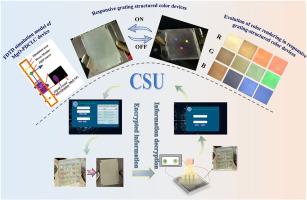Precise regulation of color rendering and multidimensional optical encryption enabled by electrically tunable all-dielectric grating devices
IF 4.2
3区 材料科学
Q2 MATERIALS SCIENCE, MULTIDISCIPLINARY
引用次数: 0
Abstract
Secure optical encryption and anti-counterfeiting technologies require platforms that are both physically reconfigurable and algorithmically robust. While electrically tunable structural color systems offer advantages like reversibility and high chromatic purity, achieving precise multi-parameter modulation and integrating them with advanced digital cryptographic methods remain a challenge. Herein, we report a novel multidimensional electro-optic encryption platform by integrating MgO-doped polymer-dispersed cholesteric liquid crystals (MgO-PDCLC) with all-dielectric nanograting structures. The key novelty of this work lies in the holistic synergy of material, device, and algorithmic innovations: Firstly, MgO doping critically enhances the electro-optic response, lowering operational voltage. Secondly, the bilayer architecture functions as a voltage-gated optical switch, dynamically concealing or revealing structural color patterns. The device's optical responses under variable voltage, incident angle, and polarization were comprehensively characterized through finite-difference time-domain (FDTD) simulations and experimental validations. A highly accurate nonlinear regression model (R2 > 0.9) was developed to quantitatively predict structural color parameters, enabling precise control. Utilizing these tunable spectral features, we propose a groundbreaking encryption scheme that seamlessly bridges physical photonic encoding and algorithmic security by coupling structural color outputs with Rivest Shamir Adleman (RSA) public-key cryptography. A dedicated software platform was implemented to realize this dual-layer encryption, enabling an information capacity up to 10n, where encryption is physically concealed without power. This work establishes a versatile framework that paves the way for next-generation secure displays, smart labeling, and anti-counterfeiting applications. Keywords: Structural color; Electro-optic tuning; Dielectric grating; Multidimensional coding; Anti-counterfeiting; Optical encryption.

通过电可调谐的全介质光栅装置实现色彩呈现和多维光学加密的精确调节
安全的光学加密和防伪技术需要具有物理可重构和算法鲁棒性的平台。虽然电调谐结构颜色系统具有可逆性和高色纯度等优点,但实现精确的多参数调制并将其与先进的数字密码方法集成仍然是一个挑战。在此,我们报道了一种新的多维电光加密平台,该平台将掺氧化镁聚合物分散胆甾液晶(MgO-PDCLC)与全介电纳米光栅结构集成在一起。这项工作的关键新颖之处在于材料、器件和算法创新的整体协同作用:首先,MgO掺杂显著增强了电光响应,降低了工作电压。其次,双层结构作为电压门控光开关,动态隐藏或显示结构颜色图案。通过时域有限差分(FDTD)仿真和实验验证,全面表征了器件在变电压、变入射角和变极化条件下的光响应。开发了高精度的非线性回归模型(R2 > 0.9)来定量预测结构颜色参数,从而实现精确控制。利用这些可调的光谱特征,我们提出了一种突破性的加密方案,通过将结构颜色输出与RSA (Rivest Shamir Adleman)公钥加密相结合,无缝连接物理光子编码和算法安全。采用专用软件平台实现这种双层加密,使信息容量达到10n,在没有电源的情况下物理隐藏加密。这项工作建立了一个通用的框架,为下一代安全显示,智能标签和防伪应用铺平了道路。关键词:结构色彩;电光调优;介质光栅;多维编码;防伪;光学加密。
本文章由计算机程序翻译,如有差异,请以英文原文为准。
求助全文
约1分钟内获得全文
求助全文
来源期刊

Optical Materials
工程技术-材料科学:综合
CiteScore
6.60
自引率
12.80%
发文量
1265
审稿时长
38 days
期刊介绍:
Optical Materials has an open access mirror journal Optical Materials: X, sharing the same aims and scope, editorial team, submission system and rigorous peer review.
The purpose of Optical Materials is to provide a means of communication and technology transfer between researchers who are interested in materials for potential device applications. The journal publishes original papers and review articles on the design, synthesis, characterisation and applications of optical materials.
OPTICAL MATERIALS focuses on:
• Optical Properties of Material Systems;
• The Materials Aspects of Optical Phenomena;
• The Materials Aspects of Devices and Applications.
Authors can submit separate research elements describing their data to Data in Brief and methods to Methods X.
 求助内容:
求助内容: 应助结果提醒方式:
应助结果提醒方式:


